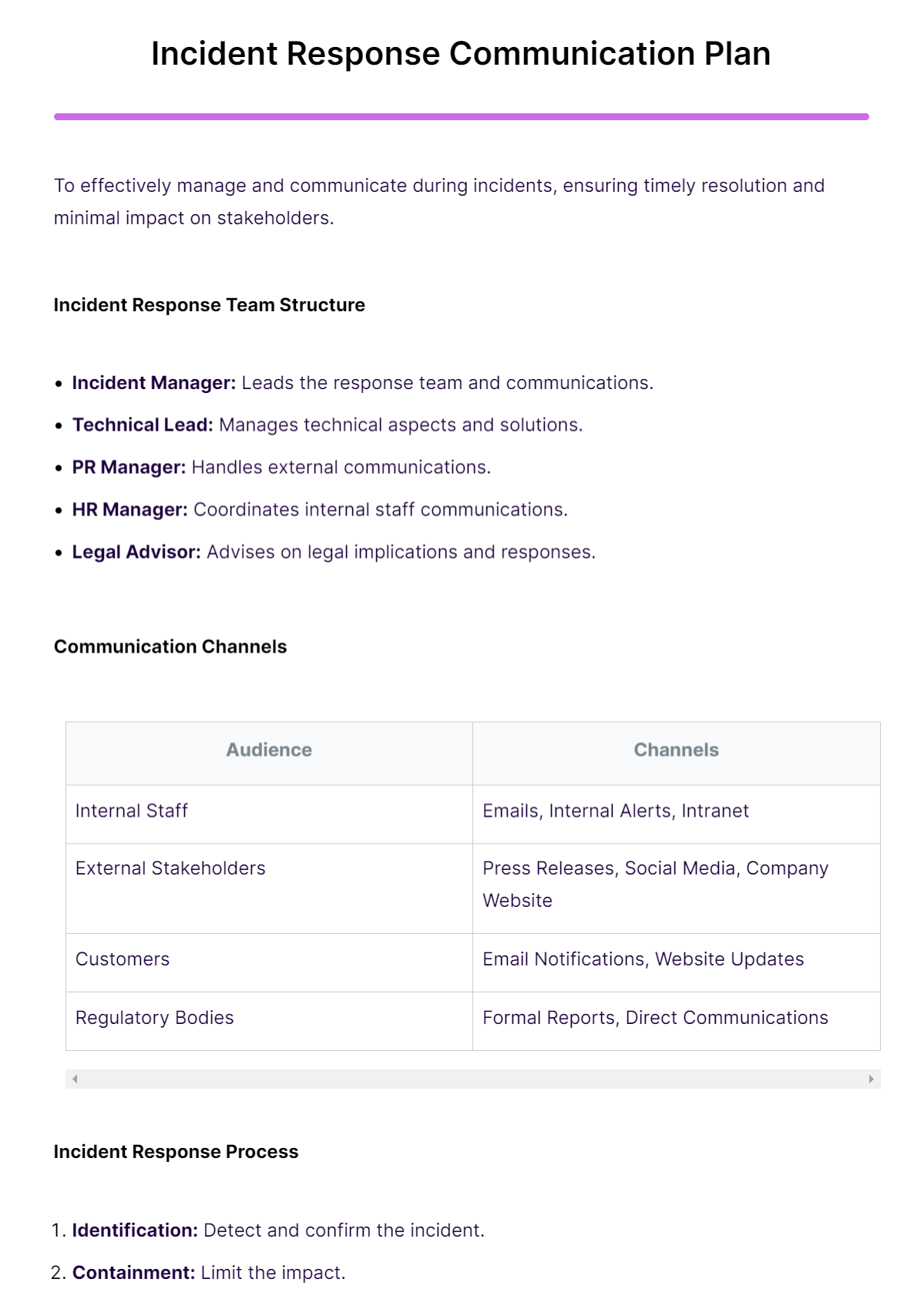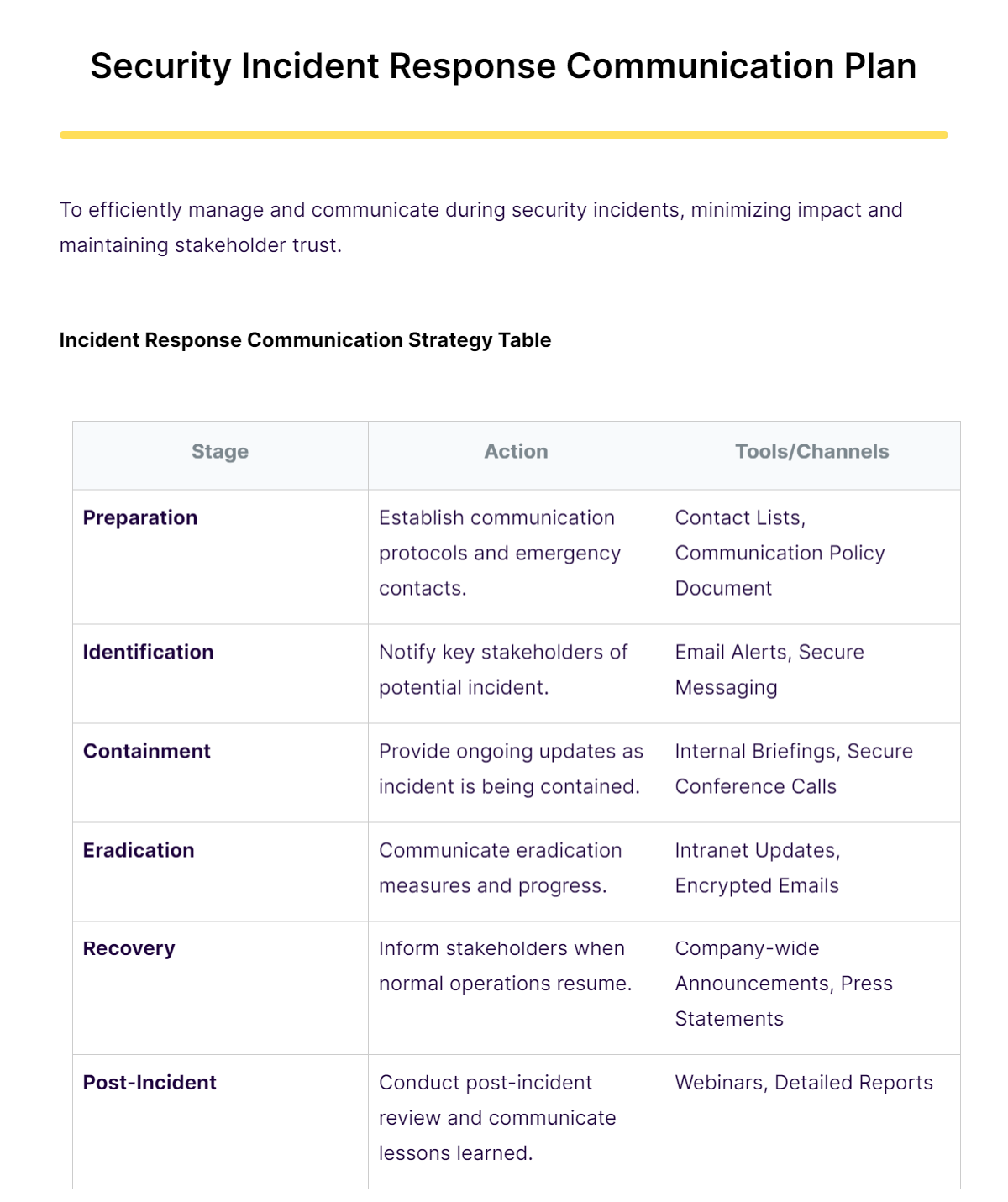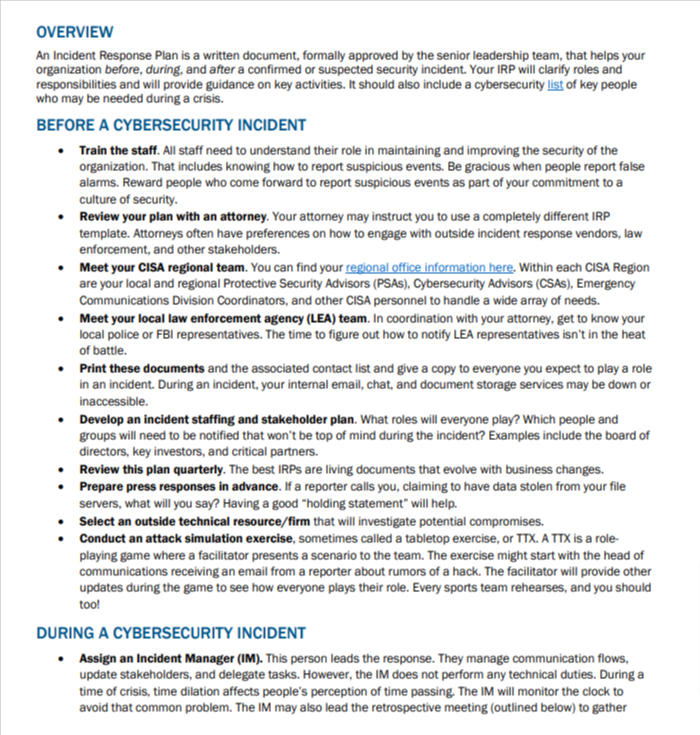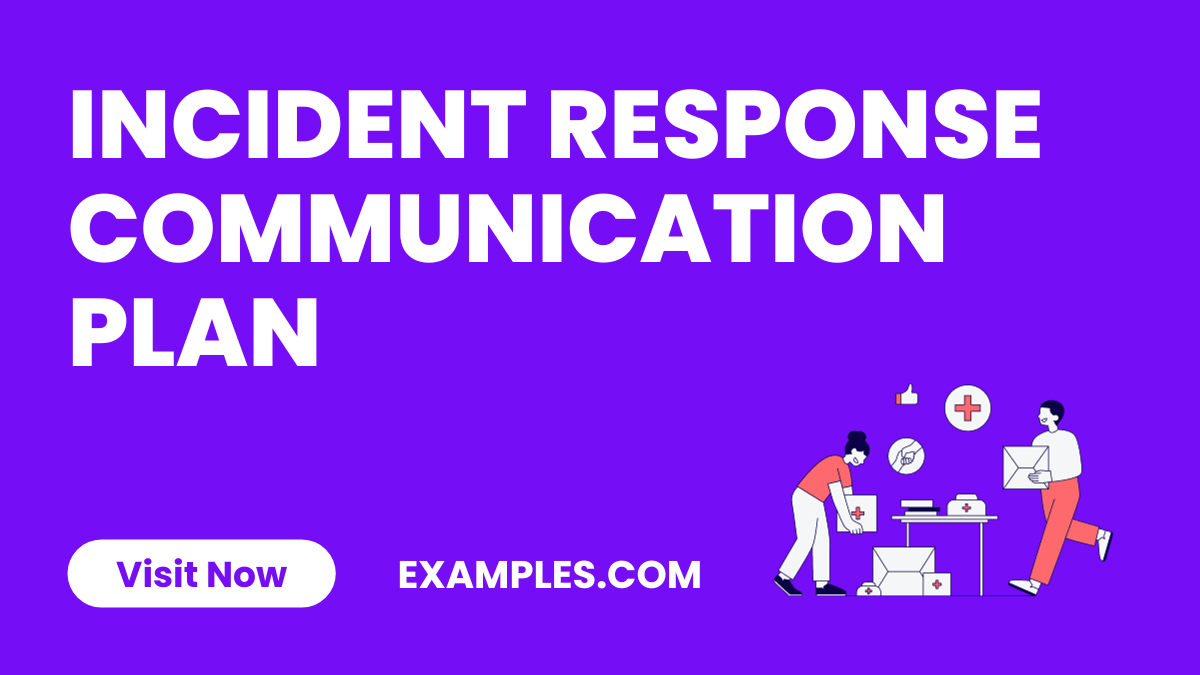Incident Response Communication Plan Example [Edit & Download]
Navigate the crucial aspects of an Incident Response Communication Plan with our detailed guide, rich in practical communication examples. This resource is essential for organizations looking to effectively manage and communicate during incidents, be it cyber attacks, security breaches, or emergencies. With tailored examples and a focus on key strategies like Risk Assessment and Response and Emergency Communication plan Procedures, this guide provides invaluable insights into developing robust communication protocols that ensure swift, efficient, and clear communication in times of crisis.
Download Incident Response Communication Plan Bundle
Incident Response Communication Plan

The document on Incident Response Communication Plan Examples provides a detailed guide for managing and communicating during incidents to ensure timely resolution with minimal stakeholder impact. It covers the structure of the incident response team, including roles like Incident Manager and PR Manager, communication channels for various audiences, and the incident response process, which involves steps like identification, containment, and resolution. The plan also details immediate response strategies, regular updates, post-incident reports, key performance indicators like response time and stakeholder satisfaction, and emphasizes the importance of regularly reviewing and adapting the plan.
Security Incident Response Communication Plan

The Security Incident Response Communication Plan provides a comprehensive guide for managing and communicating during security incidents. It details a communication strategy that includes preparation, identification, containment, eradication, recovery, and post-incident stages, each with specific actions and tools. The plan emphasizes the importance of efficient management, stakeholder trust, and regular updates throughout the incident lifecycle. Key roles, budget considerations, and performance indicators are outlined to ensure effective communication and adaptation based on feedback and evolving security landscapes
NIST Incident Response Communication Plan

The NIST (National Institute of Standards and Technology) Incident Response Communication Plan. It outlines a structured approach for managing security incidents, emphasizing timely and effective communication. The plan includes various phases like preparation, detection and analysis, containment, eradication and recovery, and post-incident activities. It also details communication channels, key roles and responsibilities, incident severity classification, performance metrics, and a review and update cycle. This comprehensive framework is designed to enhance incident response capabilities in organizations, aligning with best practices in cybersecurity incident management.
Incident Response communication Plan Basics in PDF

cisa.gov
DownloadSteps of a Cyber Incident Response Communication Plan
A Cyber Incident Response Communication Plan is essential in the digital age for managing and mitigating cyber threats effectively. It comprises structured steps ensuring prompt and coordinated actions during a cybersecurity incident. Each step of the plan is designed to manage the incident from detection to resolution, emphasizing clear, timely, and secure communication.
- Incident Identification: Quickly recognizing a security breach.
Example: “We have detected unauthorized access; initiating the response plan.” - Initial Assessment: Evaluating the scope and impact.
Example: “Assessing the extent of data compromise for immediate action.” - Communication Team Activation: Assembling the response team.
Example: “Response team, assemble for immediate briefing on the incident.” - Stakeholder Notification: Informing internal and external stakeholders.
Example: “Notifying stakeholders about the breach and ongoing actions.” - Public Relations Management: Handling media and public communications.
Example: “Our PR team will address the media with prepared statements.” - Incident Containment: Implementing measures to limit the impact.
Example: “Activating containment protocols to limit data exposure.” - Investigation and Analysis: Delving into the cause and impact.
Example: “Investigating the breach source for further insights.” - Ongoing Updates: Regular communication throughout the incident.
Example: “Providing hourly updates on incident status and resolution progress.” - Resolution and Recovery: Steps taken to resolve and recover.
Example: “Implementing recovery procedures; systems returning to normal.” - Post-Incident Review: Evaluating the response and updating plans.
Example: “Reviewing response efficacy to update our incident plan.”
Benefits of Incident Response Communication Plan Template
An Incident Response Communication Plan Template is a vital tool for any organization looking to enhance their crisis management and response capabilities. This pre-designed framework offers a systematic approach to dealing with unexpected incidents, ensuring clear, consistent, and quick communication. By utilizing this template, organizations can significantly reduce the time and resources required to develop an effective communication plan from scratch. It ensures that all team members are on the same page and that responses are swift and coordinated, ultimately safeguarding the organization’s assets, reputation, and stakeholder trust.
- Standardized Communication Protocols: This template ensures that every team member knows the exact procedures and channels for communication during a crisis.
- How to Communicate: “Please follow the standardized protocol outlined in the template for reporting incidents.”
- Quick Activation: A well-structured template allows teams to activate their response plans rapidly.
- How to Communicate: “Activate the response plan as per the second section of our template immediately.”
- Clarity in Roles and Responsibilities: Clearly defined roles prevent confusion and overlap during high-pressure situations.
- How to Communicate: “Refer to the template to understand your specific roles and responsibilities.”
- Efficient Stakeholder Notification: Templates can include pre-drafted messages for quicker stakeholder communication.
- How to Communicate: “Use the pre-drafted messages in the template to notify stakeholders promptly.”
- Consistent Messaging: Ensures that all communications are consistent and aligned with the organization’s policies.
- How to Communicate: “Ensure all communications are consistent with the messaging outlined in the template.”
Main Elements of Incident Response Communication Plan Template
Creating an effective Incident Response Communication Plan Template is crucial for swift and efficient handling of emergencies. This plan outlines procedures, identifies key personnel, and provides clear guidance for communicating during a crisis. Incorporating elements like Emergency Communication plan Procedures and Security Incident Reporting ensures a comprehensive approach to incident management.
1. Designated Response Team
Explanation: Clearly identify the members of the response team and their specific roles.
How to Communicate: “John, as team leader, your role is to coordinate the immediate response efforts.”
2. Incident Classification System
Explanation: Have a system to classify the severity of incidents to prioritize responses.
How to Communicate: “This incident is classified as Level 2, triggering our secondary response protocol.”
3. Communication Channels List
Explanation: Provide a list of all channels through which information will be communicated.
How to Communicate: “Please disseminate the update through our email list, intranet, and official social media.”
4. Stakeholder Contact Information
Explanation: Maintain a current list of all stakeholders and their contact details.
How to Communicate: “Ensure all stakeholders, including clients and partners, are informed of the situation.”
5. Notification Templates
Explanation: Pre-prepared templates for various scenarios can save time during a crisis.
How to Communicate: “Use the template for ‘data breach notification’ to inform affected parties.”
How to Use Communication Plan for Incident Response
Effectively utilizing a Communication Plan for Incident Response is pivotal in managing and mitigating crises within any organization. A well-crafted plan provides a roadmap for conveying critical information, ensuring that all stakeholders are informed and aligned during an emergency. This guide will help you understand how to leverage your communication plan to respond swiftly and effectively to incidents.
Understand the Purpose of the Communication Plan
A Communication Plan is designed to facilitate timely, accurate, and efficient exchange of information during an incident. It outlines Emergency Communication Procedures, protocols for Security Incident Reporting, and guidelines for Stakeholder Notification Process. Understanding these elements is the first step in utilizing the plan effectively.
Identify Your Key Stakeholders
Identify all parties who need to be informed during an incident. This includes internal teams, management, employees, and external entities like customers, partners, and media. Each group may require a different approach and level of detail in communication.
Determine the Communication Channels
Select the most effective channels for disseminating information during an incident. This might include emails, intranet alerts, social media, press releases, or direct phone calls. The chosen channels should be reliable, accessible, and capable of reaching your audience quickly.
Train Your Team
Ensure that all members of your team are familiar with the Incident Response Communication Plan. They should understand their roles, responsibilities, and the procedures to follow during an incident. Regular training sessions and drills will help reinforce this knowledge and prepare them for a real-world scenario.
Establish a Notification System
Implement a system for notifying stakeholders swiftly in the event of an incident. This might involve automated alerts, a phone tree, or a dedicated communication team. The system should be tested regularly to ensure it works effectively when needed.
Customize Messages for Different Audiences
Craft messages that are appropriate for each stakeholder group. Employees need detailed instructions and reassurance, while customers might require general information and assurances about their safety and the security of their data. Tailoring your communication ensures that each audience receives relevant and useful information.
Maintain a Consistent Message
Ensure that all communications are consistent in their message, tone, and facts. Inconsistent or conflicting information can lead to confusion and erode trust. Designate a spokesperson or a team responsible for all outgoing communications to maintain consistency.
Monitor and Adapt
During an incident, continuously monitor the situation and the effectiveness of your communication. Be prepared to adapt your strategy as the situation evolves. This might involve changing the frequency of updates, using different channels, or revising your messages.
Document and Review
After the incident, document all communications and the timeline of events. Review the performance of the communication plan, identify what worked well and what could be improved. This will help you refine the plan for future incidents.
Update the Plan Regularly
The Incident Response Communication Plan should be a living document that evolves over time. Regularly update it to reflect changes in your organization, technological advancements, and lessons learned from past incidents.
How to Create Incident Response Communication Plan?
Creating an effective incident response communication plan is a crucial part of any organization’s risk management strategy. This guide will walk you through the key steps:
- Identify Potential Incidents: Understand the types of incidents that could impact your organization.
- Establish a Communication Team: Assign a dedicated team responsible for managing communication during incidents.
- Define Communication Protocols: Outline how information will be communicated, including channels, formats, and frequency.
- Develop Key Messages: Prepare clear messages for different scenarios to ensure consistency and accuracy.
- Identify Stakeholders: Determine who needs to be informed, including employees, customers, and the public.
- Plan for Internal and External Communication: Create strategies for both internal communication plan team coordination and external stakeholder information.
- Train and Prepare: Conduct regular training sessions with the communication team.
- Test the Plan: Regularly test and update the plan to ensure its effectiveness.
- Post-Incident Review: After an incident, review and refine the communication plan based on what was learned.
How to Implement a Incident Response Communication Plan?
Implementing an Incident Response Communication Plan is crucial for any organization to effectively manage crises and maintain operational stability. This comprehensive guide will walk you through the steps to develop and execute an effective plan, ensuring your team is prepared to handle any emergency efficiently and effectively.
Understand the Basics of Incident Response
Before diving into the creation of a communication plan, it’s essential to understand what an Incident Management Protocol entails. Incident response involves identifying, managing, and recovering from unexpected events that threaten your organization’s information security, reputation, or operations.
Conduct a Risk Assessment and Response
Begin by conducting a thorough Risk Assessment and Response process. Identify potential threats and vulnerabilities within your organization, and assess the potential impact of different types of incidents. Understanding the risks will help you tailor your communication plan to be as effective as possible.
Formulate a Crisis Management Strategy
Develop a Crisis Management Strategy that outlines how your organization will handle various types of incidents. This strategy should include clear roles and responsibilities, decision-making processes, and procedures for assessing the severity of incidents.
Develop Emergency Communication Procedures
Establish Emergency Communication Procedures to ensure that all stakeholders are informed and updated throughout the incident. This should include protocols for internal and external communications, such as how to notify employees, customers, and the public.
Set Up a Security Incident Reporting System
Implement a Security Incident Reporting system to quickly identify and address potential threats. This system should allow employees and stakeholders to easily report suspicious activities or breaches, triggering an immediate response from your designated Response Team Coordination unit.
Define the Stakeholder Notification Process
Clearly outline the Stakeholder Notification Process in your plan. Determine who needs to be notified, when, and how. Include templates for emergency communications to streamline the process during an actual incident.
Plan for Business Continuity
Incorporate Business Continuity Planning into your communication plan. Ensure that you have strategies in place to maintain essential functions and services during and after an incident. This might include backup systems, alternative communication channels, and recovery procedures.
Establish a Cybersecurity Alert System
Implement a Cybersecurity Alert System to quickly inform your team and stakeholders of potential cyber threats. This system should provide real-time alerts and guidance on immediate actions to take.
Train and Test Your Plan
Once your plan is in place, it’s vital to train your staff and stakeholders on their roles and responsibilities. Regularly test your plan through drills and simulations to ensure everyone is prepared and the plan is effective.
Review and Update Regularly
Finally, regularly review and update your Incident Response Communication Plan to reflect new threats, technological changes, and lessons learned from past incidents. Continuous improvement will ensure your plan remains effective over time.
Incident Communications Procedures are vital guidelines outlining the roles and responsibilities of personnel during an incident. They provide a structured response plan, defining specific duties for first responders, service teams, and managers, ensuring timely and effective communication plan. These procedures are crucial in maintaining transparency, coordinating efforts, and minimizing the impact of the incident, thereby safeguarding the organization’s assets and stakeholders. Effective incident communication is key to crisis management and resolution, emphasizing the importance of preparedness and swift, coordinated action.
Creating a successful Incident Response Plan is crucial for safeguarding your organization’s digital assets. This comprehensive strategy ensures you’re prepared to handle cybersecurity incidents effectively. Start by identifying potential threats and vulnerabilities specific to your industry and organization. Next, establish a dedicated incident response team, clearly defining roles and responsibilities.



